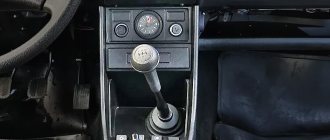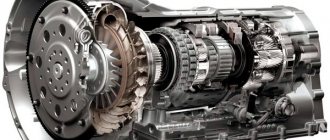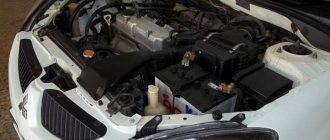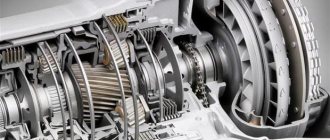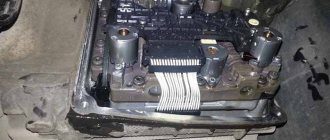DSG is a special type of transmission that combines the operating principles of a manual and automatic transmission. This preselective robotic gearbox is installed on VAG cars - Audi, Skoda, Seat and Volkswagen. One of its main advantages is that gear changes occur smoothly, without losing power flow and having a positive effect on engine efficiency.
Preselective gearbox
In fact, DSG is an abbreviation for the German concept Direktschaltgetriebe, which can be translated into Russian as “direct gearbox”. Robotic boxes of this type with 6 ranges began to be used for the first time in 2003 on the Volkswagen Golf R3 with a 6-cylinder engine producing 250 hp. Later they began to be installed not only on sports versions, but also on cars designed for the average buyer.
Robotic transmission: what is it?
The design principle and advantages of this transmission
On cars equipped with DSG, the driver independently changes gears using the gearbox accelerator, but the action itself is coordinated electronically. Such a box is similar in design and components to mechanics: primary and secondary shafts, clutch and synchronizers. What it has in common with a robot or automatic is the absence of a clutch pedal, the process of which is controlled by automation.
The DSG transmission consists of 5 shafts, several gears and 2 clutches. The precise mechanism of all components and the parallel operation of two multi-disc clutches are responsible for transmitting torque. The bottom line is that one clutch works with odd gears (as well as reverse), and the other with even ones. It turns out that if the car is moving in second gear, then the third is already ready to start working - all that remains is to release the first clutch.
The same operating principle applies to downshifting. For example, a car is moving at fifth speed, and the fourth is already engaged, its gear simply rotates idle, but will immediately start working when the engine speed drops. Thanks to this device, some cars with a preselective gearbox are faster than cars with a manual transmission. When driving a car with DSG, gear changes are imperceptible, like with a CVT. Many drivers talk about the feeling of driving in one gear. The absence of shocks when switching, which are typical for an automatic transmission and especially a manual transmission, is a definite plus.
Another significant advantage of the DSG transmission is fuel economy. According to tests by the automobile concern Volkswagen AG, savings with a manual transmission are up to 1.5 liters per hundred, which is not bad, given the high prices of fuel in Russia and Europe.
Transmission fluid
The DSG-6 gearbox is also internally marked DQ-250. Unlike the same 7-speed DQ-200, it has an important difference in design. The clutch unit of the DSG-6 is immersed in an oil bath, where it remains regardless of whether the gearbox is working or not. Therefore, the “six” is often called a “wet” transmission. Its operation requires more oil (about 6-6.5 liters) than the more modern DSG-7 (2 liters).
Regular replacement of lubricant is necessary for a 6-speed robot, while a 7-speed gearbox has a dry clutch, so it does not require maintenance and replacement of transmission fluid according to factory regulations.
When purchasing or operating a car with a DSG-6 gearbox, remember that its long service life directly depends on 3 factors. This means timely oil changes in the transmission, minimal driving in slip mode and reduced time spent stuck in traffic jams.
Filling with new oil
Then you should fill the DSG-6 preselective gearbox with new fluid. Some people pour it directly into the filter hole. But this is a very long time. It is best to find a special adapter that is screwed in instead of the oil fill plug, and two meters of hose. A funnel is pulled onto the top of the hose and the product is poured in.
According to the manufacturer, the box should contain about seven liters. But in reality only five are included. Next, the engine is started, and the funnel is kept where it was. Then the box switches to different modes. After this, check the level.
The funnel is removed and a bottle of oil is placed in its place. The bottle needs to be placed on the floor. Excess oil will drain into it. When the liquid stops flowing and only drips, the adapter can be unscrewed.
When to change the oil in DSG-6 gearboxes
Changing transmission oil in such gearboxes must be carried out strictly according to the regulations described in the vehicle maintenance manual. More than 90% of DSG-6 breakdowns are due to untimely requests to change the oil in the transmission and violation of the rules for operating the engine or gearbox.
Transmission repair cannot be called a low-cost pleasure - in a number of regions the cost is above 50,000 rubles. Solenoid valves in the mechatronics of the gearbox often fail, which already threatens expenses of more than 100,000 rubles. However, in general, the “six” is recognized as one of the most reliable robotic transmissions, which, with proper maintenance, can last 200-250 thousand kilometers without major repairs.
For most Volkswagen, Audi and Skoda cars, the manufacturer indicates that transmission fluids in DSG-6 gearboxes are replaced when the mileage reaches 60 thousand kilometers. However, most experts recommend carrying out this procedure much earlier - at 40 thousand kilometers on the car’s odometer.
Many car owners note that changing the oil in a DSG of any type helps to get rid of jerking and jerking in operation, the car drives more smoothly, and it seems that a new transmission has been installed. This is another reason for changing the gearbox oil earlier than the time recommended by the manufacturer.
Typical "diseases"
DSG-6 oil changes must be carried out strictly according to the manufacturer’s regulations - they can be seen in the instructions for the car. Almost all typical breakdowns occur due to untimely change of transmission fluids.
The multi-plate friction clutch wears out very often. Most often this manifests itself in the periodic lack of loading of the reverse gear and in jerks when changing even gears. The gearbox can go into emergency mode. In this case, it is impossible to engage odd-numbered gears. DSG repair in this case means replacing the entire friction clutch or replacing individual discs. Next, basic setup and adaptation is performed.
Also, one of the problems with these boxes is the wear of the solenoids that regulate the pressure in the mechatronics. In this case, you may feel jerking when switching. The breakdown does not cause errors. The problem can be solved by replacing the solenoids. In some cases, mechatronics are also completely replaced.
Certain problems may arise with the mechatronics electronic unit. They are usually detected during a cold engine start. The DSG-6 box will go into emergency mode once. Sometimes, for the same reason, the gearbox may periodically go into emergency mode. Operation can be restored by replacing the mechatronics or repairing the unit.
Often, technicians diagnose wear on the input shaft bearing and other bearings. Differentials also fail. This is manifested by increased noise when driving, braking, and accelerating. The problem can be solved by overhauling the DSG using high-quality used spare parts.
Changing the oil in the DSG: what is needed and how to perform the procedure yourself?
Selecting transmission lubricant
Replacing the fluid in a gearbox of this type will require transmission oil for dual-clutch transmissions DSG - VAG G052182A2 in the amount of 6 liters, oil filter VAG 02E305051C, as well as a drain plug sealing ring under article number N91084501.
A number of drivers prefer the VAG fluid to use Pentosin FFl-2 transmission oil, which is 300-350 rubles per liter cheaper. It has the same VW TL 521 82 approval, which guarantees stable operation of dual-clutch transmissions of the DSG type. The main thing is to never mix one with the other in any proportions. If you choose VAG, then pour only it, if, on the contrary, Pentosin, then use all the oil of this model.
The easiest and most reliable way to change the fluid in dual clutch transmissions is to contact the dealer, as certain equipment and skills will be required, and you can also get a guarantee on the work from a certified center. The estimated cost of the procedure, including all consumables (filter, oil, seal, etc.) will be 10-12 thousand rubles. If you decide to replace the transmission fluid in the gearbox yourself, the savings will be about 3-4 thousand. True, you will have to devote 2-3 hours of free time and acquire a tool.
Process steps
First of all, the machine is lifted on a lift or installed on a pit. It is recommended to install the gearbox selector in parking. Next, unscrew the drain plug on the gearbox housing. First, a liter of liquid will pour out of the box. Then you need to unscrew the control tube - about five more liters will flow out. If chips leak out along with the oil, then this is a reason to contact a service center to repair the box.
Next, the filter is replaced. On many cars (including Skoda) with DSG-6 the filter is located higher. To access it, you need to remove the battery along with the platform, the air filter housing and the air ducts. Then you can unscrew the filter.
How does the DSG box work?
The basis of this transmission is a conventional manual transmission (MT), consisting of two shafts and more than a dozen gears. The input shaft gears are part of it, so they always rotate with it. The gears of the secondary shaft rotate freely on it thanks to sliding couplings. The shift fork moves the clutch so that it engages one of two speeds, for example, first and second or fifth and sixth. In order for the stages (gears) to engage without grinding or damaging the mechanism, a synchronizer is installed between the gear and the clutch.
Despite the general principle of operation, DSG is very different from manual transmission. After all, it combines 2 separate boxes. One switches even gears, the other odd. In addition, each half has its own clutch, which, depending on the type of unit, is dry or wet. The dry clutch is made on the same principle as a conventional car clutch. And the wet one got its name because it works in an oil bath and is a friction clutch from an automatic transmission.
DSG gearbox
Such a complex structure is controlled by mechatronics - an electronic-hydraulic unit, using solenoids (electromagnets) and hydraulic cylinders. This design turned out to be more efficient and reliable than the purely electronic one, which was installed on robotic gearboxes (manual transmissions) of the first generations. You will find more detailed information about the design and operating principles of these transmissions here (Volkswagen Jetta DSG box).
What DSGs were installed on the Jetta?
The Volkswagen Jetta was equipped with 4 DSG models, the names of which began with the letters DQ:
- The 250 was the first six-speed gearbox with a wet clutch and received a lot of negative reviews.
- The 200 was the first seven-speed transmission with a dry clutch, and became the leader in the number of complaints. Due to the limitation of maximum torque, it was installed only in conjunction with low-power engines of up to two liters.
- The 381 is a seven-speed wet clutch transmission that can handle the highest torque. It began to be installed only in 2021.
- 400 – six-speed transmission with wet clutch, withstanding 400 Nm of torque. The first models with this unit appeared in 2021.
Gearbox DSG DQ 400
All wet clutch units are designed the same, so they use the same technology to change the oil.
Recommendations
Comments 17
When I drained the oil, I measured the volume. It turned out exactly 4.5 liters.
I changed it at the dealer. I was watching. We poured it through a filter, 4.5-4.6 liters was enough to set the level.
But I filled it through the filter with a syringe with a rubber seal on the spout (under pressure). Oil practically does not flow by gravity.
How do the rugs run, my friend?!))
According to manual 5.5, when 6 bottles are completely replaced, watering is required
Read more: How much does it cost to adjust a carburetor?
When changing the oil completely, it doesn’t all pour out, so they unscrew the cap, the filter, the slurry is drained, then they pour a little through the filter, fresh oil with a density higher than the used one and it pushes out the whole hat, then they screw in the measure and fill in the rest, Profit)
6 bottles for the eyes and a hundred grams left
When changing the oil completely, it doesn’t all pour out, so they unscrew the cap, the filter, the slurry is drained, then they pour a little through the filter, fresh oil with a density higher than the used one and it pushes out the whole hat, then they screw in the measure and fill in the rest, Profit)
Nonsense. There are about 8 liters in the box, when replacing, only about 4.5-5 are drained, the rest remains in the clutch. Therefore, spilling 50-100 ml of old oil to wash off along the way from the filter to the drain plug simply does not make sense. I changed it twice, 5L was enough each time. According to the dealer’s technology, you need 6 cans, they will fill about 5.5, then they will stupidly pour out the extra almost liter
An interesting specimen. From this angle it is not immediately clear what kind of car is in the photo. It seems like an Octavia, but what does DSG6 have to do with it? The Skoda transmission was equipped with either a six-speed manual or DSG7 with two dry clutches. In those years when the problem of weak clutches was widespread and customers replaced them in droves under warranty, regular hydraulic automatic machines were installed on the Octavia - those were wonderful times!
However, they are found on Octavia and DSG6 with wet double clutch. Such engines have a volume of 2 liters and TSI type. Externally, the 1.8 TSI is no different from the two-liter. Here we have just the top version of the Octavia RS with a 2.0 TSI engine.



